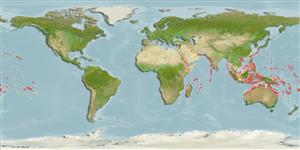Common names from other countries
>
Blenniiformes (Blennies) >
Blenniidae (Combtooth blennies) > Salariinae
Etymology: Exallias: Greek, exallias = strange, marvellous (Ref. 45335).
More on author: Kner.
Environment: milieu / climate zone / depth range / distribution range
Écologie
marin récifal; profondeur 3 - 20 m (Ref. 9710), usually 3 - 8 m (Ref. 58302). Tropical; 30°N - 30°S
Indo-Pacific: Red Sea south to Sodwana Bay, South Africa (Ref. 4404) and east to the Hawaiian, Marquesan, and Society islands, north to the Ryukyu and Bonin islands, south to New Caledonia and Rapa.
Taille / Poids / Âge
Maturity: Lm ? range ? - ? cm
Max length : 14.5 cm TL mâle / non sexé; (Ref. 9710)
Épines dorsales (Total): 12; Rayons mous dorsaux (Total): 12-13; Épines anales 2; Rayons mous anaux: 14 - 15. Numerous papillae on the upper lip, smaller and more closely spaced spots. Nuchal cirri: 30 - 36.
Adults occur on clear coastal reefs, often in bays and semi-exposed habitats (Ref. 48636). Found on the seaward edge of reefs, among corals like Acropora, Pocillopora, Seriatopora, Porites, and Millepora where they feed on coral tissues (Ref. 1602). Benthic (Ref. 58302). Males prepare nesting sites by overgrazing a patch of coral (Ref. 9710). Oviparous. Eggs are demersal and adhesive (Ref. 205), and are attached to the substrate via a filamentous, adhesive pad or pedestal (Ref. 94114). Larvae are planktonic, often found in shallow, coastal waters (Ref. 94114). Minimum depth reported taken from Ref. 30874.
Life cycle and mating behavior
Maturité | Reproduction | Frai | Œufs | Fécondité | Larves
Oviparous, distinct pairing (Ref. 205).
Myers, R.F., 1991. Micronesian reef fishes. Second Ed. Coral Graphics, Barrigada, Guam. 298 p. (Ref. 1602)
Statut dans la liste rouge de l'IUCN (Ref. 130435)
Warning: mysqli::__construct(): (HY000/1040): Too many connections in /var/www/html/includes/func_getlabel.php on line 46
Can't connect to MySQL database (fbapp). Errorcode: Too many connections
